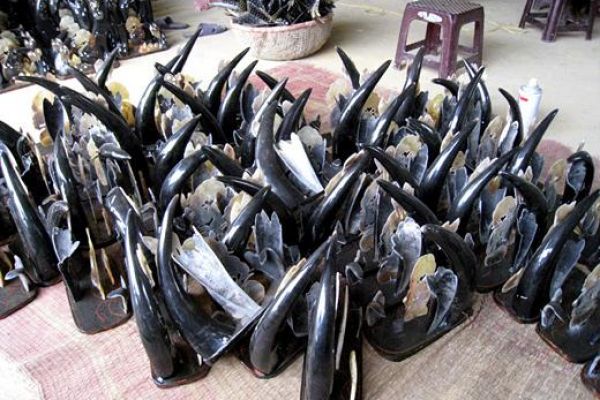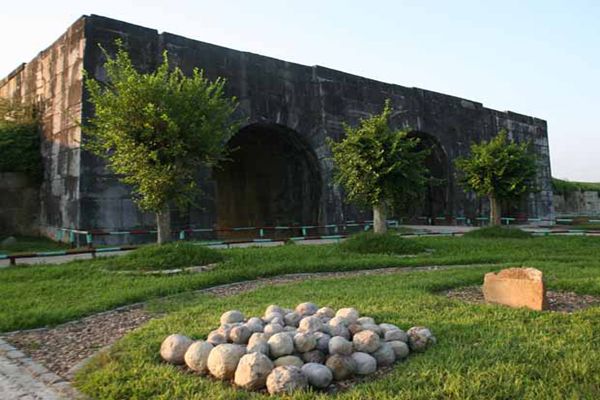
How to give them a new lease on life
Do Hai Village in An Lao commune, Binh Luc district, is just like many others in the Red River Delta. They have one thing in common: along the village road are shops offering a large selection of goods - dragons, phoenixes, eagles, turtles, and many other fine-art products made from cattle horns.
The horn-carving craft started in 1927 and has helped villagers survive between-crop periods for many years, according to 84-year-old artisan Nguyen Trong Ba.
 |
Initially, they carved simple things such as combs, brushes and hairpins. Gradually, they have developed their skills to make fine-art products.
With more than 65 years’ experience in the job, Ba's products are famous for their exellence.
"In the past, children could not help but follow parents’ instructions,” Ba recalls. “When I was a little boy, my father taught me the basic skills of carving the most simple things, and how to analyse samples that customers gave us to duplicate."
Presently, Ba is often asked by his old clients to make big things such as the tam da (the three gods of abundances: happiness, wealth, and longevity), dragons and eagles. The villagers call him ‘artisan Ba’, since his products are intricately carved by hand in different patterns.
After the Thanh Son Handicraft Co-operative was established in 1960 the traditional craft continued to develop in the village and most of its products were exported to Eastern Europe.
However, it hit snags during the years of subsidised economy, which lasted until 1986 because the supply of cattle horns and hooves was running short. During that time, if people wanted to kill cattle, they had to ask the authorities for permission. Only after the country adopted an open-door policy and began the Doi Moi (Renewal) process in 1986, were people allowed to slaughter their cattle freely. Ever since the horn carving craft has become a good income earner for many families.
Among famous products attracting many Asian customers, African bull horns are sold for VND1 million each because they are made by hand. Most of the products are exported through outlets in Hanoi, Hue and HCM City to the Chinese market.
"In the last two years, customers have pulled in their horns because of the economic crisis," says village chief Nguyen Van Huy.
Nguyen Van De and his wife Nguyen Thi Quyen began the craft in 1992. Their fine-art products, including dragons, phoenixes, peacocks, elephants, buffalo and swans, are mostly exported to China. The couple now owns a small workshop with ten workers. Everyday, they work 10 hours from 7am to 5pm.
 |
“Some Western customers have come here to put in advance orders for special products,” De says with a sense of pride in his work.
One of the secrets behind his success is how to choose good horns.
"White horns are 10 times more expensive than black horns,” he explains.
"The horns of male buffaloes are big and hollow and those of female buffaloes are small and solid. The horns of young buffaloes and cows are soft, so these can be easily damaged by termites.
"Among these materials, the horns of big, old female buffaloes are the best because products made of these horns will not be damaged by termites," says De. He has invested VND50 million (US$2,700) in equipment. The workshop earns about VND70 million a month (US$3,783), and each worker is paid VND30,000 (US$1.6) a day.
"I want to reduce costs even more, but this would hurt our workers' incomes," says De.
"The commune People's Committee chairman, Le Xuan Cat,regularly encourages us to maintain the craft, because it can create more jobs for locals. Even now, with the craft being on the horns of a dilemma, I still want to preserve it."
He argues that the craft can bring families a bigger income than growing vegetables.
"This is our traditional job. We must try our best to maintain it to help jobless people make ends meet. We always encourage young people, even children with disabilities, to learn horn-carving skills," he says.
"We have built a showroom and a service centre to promote trade with other communes".
Meticulous work
While the younger generations prefer to produce a large volume of products on a commercial scale, the village still has some veteran workers who love to focus on masterpieces that require them to be very meticulous.
In an old house beside a pomelo garden, an elderly man is busy at work, making products from a pile of horns. Nguyen The Kiem, 76, is one of the few veteran carvers who have made top-quality fine-art products including the statues of celebrities like poet Nguyen Khuyen (1835-1909).
Born in Binh Luc, Kiem began to do the job very early when he was still a little boy, simply carving combs out of buffalo horn. Today he is a master carver, having many of his famous products displayed at trade fairs. Kiem was recognised by the Government as an Artisan in 2004.
By Hoang Trung Hieu










(84-63) 3 826042 – (84-63) 3 511142
No 54 Nguyen Dinh Chieu, Ham Tien Central Mui Ne Beach Binh Thuan Vietnam
523 To Hien Thanh District 10 Ho Chi Minh City Vietnam
Ha Long Halong City Quang Ninh Vietnam
A13 Hung Thong 2 Halong City Quang Ninh Vietnam




